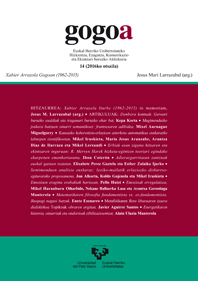Kausazko koherentzia-erlazioen azterketa automatikoa
##plugins.themes.bootstrap3.article.main##
##plugins.themes.bootstrap3.article.sidebar##
Argitaratua
2016-02-17
Mikel Iruskieta
Maria Jesus Aranzabe
Arantza Diaz de Ilarraza
Mikel Lersundi
Laburpena
Detecting automatically the cause relations of a text may be useful in question answering tasks and event information extraction. The aim of this paper is to study how to detect coherence relations of the cause subgroup (Cause, Result and Purpose). To achieve this aim we have used the Rhetorical Structure Theory (RST) and some automatic linguistic information from different tools developed by IXA Group. We have used a corpus of 60 scientific abstracts, the Basque RST Treebank (Iruskieta et al., 2013), of different domains: science, medicine and terminology. A linguist has annotated all the signals of that corpus and described the most important problems in such task. To report the reliability of this annotator, two linguists have annotated the signals of the cause subgroup and all the annotations were compared and evaluated. After that, a superannotator has harmonized all the signals of those cause relations. Finally, we show the most important signals for such relations.
Nola aipatu
Iruskieta, M., Aranzabe, M. J., Diaz de Ilarraza, A., & Lersundi, M. (2016). Kausazko koherentzia-erlazioen azterketa automatikoa. Gogoa, 14. https://doi.org/10.1387/gogoa.15628
##plugins.themes.bootstrap3.article.details##
Atala
Artikuluak

